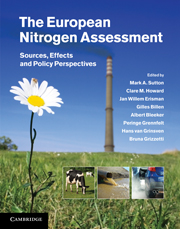Book contents
- Frontmatter
- Contents
- List of contributors
- Foreword
- Summary for policy makers
- Technical summary
- 1 Assessing our nitrogen inheritance
- Part I Nitrogen in Europe: the present position
- Part II Nitrogen processing in the biosphere
- Part III Nitrogen flows and fate at multiple spatial scales
- 10 Nitrogen flows in farming systems across Europe
- 11 Nitrogen flows and fate in rural landscapes
- 12 Nitrogen flows and fate in urban landscapes
- 13 Nitrogen flows from European regional watersheds to coastal marine waters
- 14 Atmospheric transport and deposition of reactive nitrogen in Europe
- 15 Geographical variation in terrestrial nitrogen budgets across Europe
- 16 Integrating nitrogen fluxes at the European scale
- Part IV Managing nitrogen in relation to key societal threats
- Part V European nitrogen policies and future challenges
- Glossary
- Index
- References
12 - Nitrogen flows and fate in urban landscapes
from Part III - Nitrogen flows and fate at multiple spatial scales
Published online by Cambridge University Press: 16 May 2011
- Frontmatter
- Contents
- List of contributors
- Foreword
- Summary for policy makers
- Technical summary
- 1 Assessing our nitrogen inheritance
- Part I Nitrogen in Europe: the present position
- Part II Nitrogen processing in the biosphere
- Part III Nitrogen flows and fate at multiple spatial scales
- 10 Nitrogen flows in farming systems across Europe
- 11 Nitrogen flows and fate in rural landscapes
- 12 Nitrogen flows and fate in urban landscapes
- 13 Nitrogen flows from European regional watersheds to coastal marine waters
- 14 Atmospheric transport and deposition of reactive nitrogen in Europe
- 15 Geographical variation in terrestrial nitrogen budgets across Europe
- 16 Integrating nitrogen fluxes at the European scale
- Part IV Managing nitrogen in relation to key societal threats
- Part V European nitrogen policies and future challenges
- Glossary
- Index
- References
Summary
Executive summary
Nature of the problem
Although cities take only 1.5%–2% of the Earth's land surface, due to their dense population, settlement structure, transportation networks, energy use and altered surface characteristics, they dramatically change the regional and global nitrogen cycle. Cities import and concentrate Nr in the form of food and fuel, and then disperse it as air and water pollution to other ecosystems covering much larger areas.
Approaches
A mass-balance approach was used in order to quantify the fluxes of reactive nitrogen (Nr) in and out of cities.
Cities can be characterised either as a source of Nr (i.e. emitting large amounts as liquid or solid household waste, automobile exhaust, air pollution from power plants) or a sink of Nr (through importing more food, fossil fuels, etc., and having fewer emissions to the air and water).
Paris metropolitan area is used as a case study, which represents an evolving European capital with much available data.
Key findings/state of knowledge
The Paris Metropolitan Area changed from being a sink in the eighteenth and nineteenth centuries to a source of Nr today. Major changes in the city functioning occurred before 1950, but especially recent decades have been characterised by an unprecedented amplification of those changes.
[…]
- Type
- Chapter
- Information
- The European Nitrogen AssessmentSources, Effects and Policy Perspectives, pp. 249 - 270Publisher: Cambridge University PressPrint publication year: 2011
References
- 11
- Cited by



